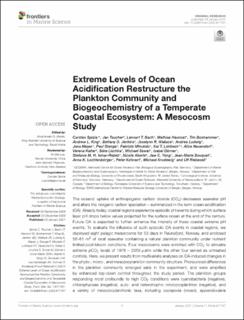| dc.contributor.author | Spisla, Carsten | |
| dc.contributor.author | Taucher, Jan | |
| dc.contributor.author | Bach, Lennart T | |
| dc.contributor.author | Haunost, Mathias | |
| dc.contributor.author | Boxhammer, Tim | |
| dc.contributor.author | King, Andrew L | |
| dc.contributor.author | Jenkins, Bettany D. | |
| dc.contributor.author | Wallace, Joselynn R. | |
| dc.contributor.author | Ludwig, Andrea | |
| dc.contributor.author | Meyer, Jana | |
| dc.contributor.author | Stange, Paul | |
| dc.contributor.author | Minutolo, Fabrizio | |
| dc.contributor.author | Lohbeck, Kai T. | |
| dc.contributor.author | Nauendorf, Alice | |
| dc.contributor.author | Kalter, Verena | |
| dc.contributor.author | Lischka, Silke | |
| dc.contributor.author | Sswat, Michael | |
| dc.contributor.author | Dörner, Isabel | |
| dc.contributor.author | Ismar-Rebitz, Stefanie M. H. | |
| dc.contributor.author | Aberle, Nicole | |
| dc.contributor.author | Yong, Jaw C | |
| dc.contributor.author | Bouquet, Jean-Marie | |
| dc.contributor.author | Lechtenbörger, Anna K. | |
| dc.contributor.author | Kohnert, Peter | |
| dc.contributor.author | Krudewig, Michael | |
| dc.contributor.author | Riebesell, Ulf | |
| dc.date.accessioned | 2021-09-10T08:28:06Z | |
| dc.date.available | 2021-09-10T08:28:06Z | |
| dc.date.created | 2021-01-05T11:00:08Z | |
| dc.date.issued | 2021 | |
| dc.identifier.citation | Frontiers in Marine Science. 2021, 7, . | en_US |
| dc.identifier.issn | 2296-7745 | |
| dc.identifier.uri | https://hdl.handle.net/11250/2775139 | |
| dc.description.abstract | The oceans’ uptake of anthropogenic carbon dioxide (CO2) decreases seawater pH and alters the inorganic carbon speciation – summarized in the term ocean acidification (OA). Already today, coastal regions experience episodic pH events during which surface layer pH drops below values projected for the surface ocean at the end of the century. Future OA is expected to further enhance the intensity of these coastal extreme pH events. To evaluate the influence of such episodic OA events in coastal regions, we deployed eight pelagic mesocosms for 53 days in Raunefjord, Norway, and enclosed 56–61 m3 of local seawater containing a natural plankton community under nutrient limited post-bloom conditions. Four mesocosms were enriched with CO2 to simulate extreme pCO2 levels of 1978 – 2069 μatm while the other four served as untreated controls. Here, we present results from multivariate analyses on OA-induced changes in the phyto-, micro-, and mesozooplankton community structure. Pronounced differences in the plankton community emerged early in the experiment, and were amplified by enhanced top-down control throughout the study period. The plankton groups responding most profoundly to high CO2 conditions were cyanobacteria (negative), chlorophyceae (negative), auto- and heterotrophic microzooplankton (negative), and a variety of mesozooplanktonic taxa, including copepoda (mixed), appendicularia (positive), hydrozoa (positive), fish larvae (positive), and gastropoda (negative). The restructuring of the community coincided with significant changes in the concentration and elemental stoichiometry of particulate organic matter. Results imply that extreme CO2 events can lead to a substantial reorganization of the planktonic food web, affecting multiple trophic levels from phytoplankton to primary and secondary consumers. | en_US |
| dc.language.iso | eng | en_US |
| dc.publisher | Frontiers Media | en_US |
| dc.rights | Navngivelse 4.0 Internasjonal | * |
| dc.rights.uri | http://creativecommons.org/licenses/by/4.0/deed.no | * |
| dc.title | Extreme Levels of Ocean Acidification Restructure the Plankton Community and Biogeochemistry of a Temperate Coastal Ecosystem: A Mesocosm Study | en_US |
| dc.type | Peer reviewed | en_US |
| dc.type | Journal article | en_US |
| dc.description.version | publishedVersion | en_US |
| dc.source.pagenumber | 24 | en_US |
| dc.source.volume | 7 | en_US |
| dc.source.journal | Frontiers in Marine Science | en_US |
| dc.identifier.doi | 10.3389/fmars.2020.611157 | |
| dc.identifier.cristin | 1865371 | |
| dc.relation.project | Norges forskningsråd: 160016 | en_US |
| dc.description.localcode | Copyright © 2021 Spisla, Taucher, Bach, Haunost, Boxhammer, King, Jenkins, Wallace, Ludwig, Meyer, Stange, Minutolo, Lohbeck, Nauendorf, Kalter, Lischka, Sswat, Dörner, Ismar-Rebitz, Aberle, Yong, Bouquet, Lechtenbörger, Kohnert, Krudewig and Riebesell. This is an open-access article distributed under the terms of the Creative Commons Attribution License (CC BY). The use, distribution or reproduction in other forums is permitted, provided the original author(s) and the copyright owner(s) are credited and that the original publication in this journal is cited, in accordance with accepted academic practice. No use, distribution or reproduction is permitted which does not comply with these terms. | en_US |
| dc.source.articlenumber | 611157 | en_US |
| cristin.ispublished | true | |
| cristin.fulltext | original | |
| cristin.qualitycode | 1 | |

